Ijraset Journal For Research in Applied Science and Engineering Technology
- Home / Ijraset
- On This Page
- Abstract
- Introduction
- Conclusion
- References
- Copyright
Charging and Its Evolution
Authors: Joydeep Chandra, Vikram Kumar Jha, Neha Sharma
DOI Link: https://doi.org/10.22214/ijraset.2023.50417
Certificate: View Certificate
Abstract
From using removable and replaceable battery cells human felt that if the power can be recharged in the same battery pack many times, then it can be a great option when there will be power need instantly, they can get. It was a huge challenge like charging DC battery with AC power. When charging became possible, it was slow and charging large capacity was not possible. Then break through technologies in charging started to come up with higher watts and higher capacities. Further to add a feather in the cap, wireless charging came into existence which is still growing by leaps and bound and air charging is the latest innovation of charging world whose further research and development is being carried out.
Introduction
I. INTRODUCTION
Wired charging is done using a wire and is primarily used in the charging of consumer electronics similar to mobile phones, laptops, tablets, and other, electric vehicles and numerous other products used in the energy & power sectors, of healthcare. Wired charging plays an important role in the daily lives of humans, as everyone is girdled by chargeable widgets. The rise in demand for mobile & laptops in this decade led to increased demand for wired charging, which acts as the major driving factor for the request. In addition, the rise in demand for electric vehicles also boosts the demand for wired charging. Also, The U.S, China, and Japan are developed nations that play a significant role in the wired charging market. The world’s third-largest light-duty draw-in vehicle country market in Japan. Wired charging will reach 11.1 billion markets by 2020, crossing the most wired point they assessed. And it is projected to reach 15.9 billion by 2030, growing at a CAGR of 3.9% from 2020 to 2030.
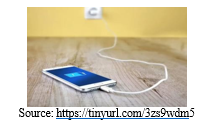
II. HISTORY
Here’s a look back, More than 80 years have seen a huge change in charging technology. The firstly Invention of the Battery was In 1859, The French physician Gaston Plante invented the first Rechargeable Battery based on Lead Acid. and since then, improvements and developments have been happening to feed to the demands of time. Car batteries have incorporated significant innovations made in lead acid battery technology. The greater part of an overall generation of lead goes into batteries. At present, the lead acid battery has a positive cathode of lead peroxide (PbO2) and a negative terminal of lead (Pb). An electrolyte is a sulphuric corrosive arrangement with particular gravity in the range of 2.12 to 1.30 (28% to 39% by weight).
And it’s Limitation is:- In a lead-acid battery, sulphuric acid (36%) and water (64%) are typically used as electrolytes. During battery recharge, hydrogen gases from this electrolyte vaporize and cause highly flammable gases which are hazardous.
The electrode plates dipped inside the electrode increase the weight of battery which weighs about 30 to 60 pounds on average.

The original intent of wireless energy commerce, where EM waves transmit the energy, is electromagnetism. H.C. Oersterd's discovery that an electromagnetic field is generated around an electric flow garnered attention in electromagnetism in 1819. Ampere's Law, Biot’s Law, Savart's, and Faraday's Law were later developed to provide some key attributes of the magnetic field. Following them, In 1864, J.C. Maxwell was knowledgeable about a few circumstances illustrating how electric and magnetic fields are delivered and modified by one another. The force of magnetism was finally united in 1873 with the publication of Maxwell's book "A Treatise on Electricity and Magnetism". Power and attraction are said to be limited by an equivalent power today and for the foreseeable future.
Later, rotating flow power inventor Nicolas Tesla was the first to conduct a test of wireless force trading using microwaves. He focused on long-distance wireless force movement and understood the exchange of microwave flags over a 48 km-long partition in 1896. Another significant breakthrough occurred in 1899 when 108 volts of high- recurrence electric control were transmitted over a distance of 25 miles in order to power 200 lamps and an electric motor. However, Tesla's innovation must be retracted since transferring such high voltages through electric bends would have serious repercussions for people in close proximity and electrical equipment.
III. CHARGING TECHNOLOGIES
In this section, the central data of charging has been given which covers the standard of developments, and existing utilization of that advancement. What's more, also the charging system design in engineering, equipment hardware, and usage.
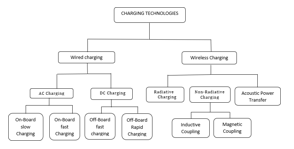
IV. OVERALL CHARGING SYSTEM
A. Wired Charging
- AC Charging: AC charging indirectly charges the battery via the OBC, which can be classified into two groups: OB slow charging and OB fast charging.
- ON-Board Slow Charging: OB slow charging typically requires multi-stage conversions (i.e., AC-DC and DC- DC), which inherently leads to low-voltage ripples and a relatively high power rating. Thus, it is widely used as an OBC inside BEVs such as for level 1 AC charging (i.e., input voltage: 1120 or 220 V, charging power: below 2 kW, and battery voltage (VB): DC 240 ~ 325 V) in a number of BEV models on the market (e.g., Tesla Model 3, Toyota RAV4, etc.).
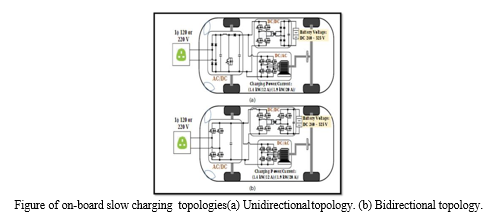
3. ON-Board Fast Charging: Compared to the 1? OB slow charging technologies, the 3? OB fast charging technologies can provide a faster charging capability because of their medium power rating (about 20 kW); i.e., they can charge the battery up
to 80% within a charging time ranging between 2 ~ 3.5 h.
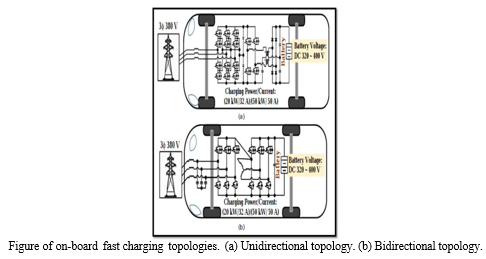
4. DC Charging: The DC charging technologies for BEVs are discussed below. They can be classified into two groups: off-board fast charging and off-board rapid charging
5. Off-Board Fast Charging: The presence of the rectifying unit and the charging station battery. As a result, they can achieve an overall reduced size and weight of the driving system. DAB topologies are the most common for these specific charging technologies.
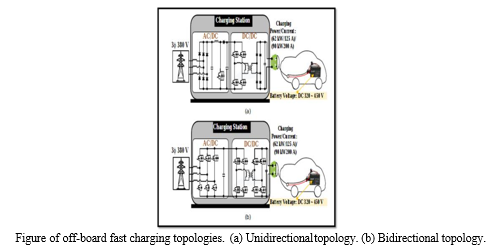
6. Off-Board Rapid Charging: An extended form of fast charging technologies can be set up in the so-called rapid- fire charging technologies, which use further power and charging current. In these charging approaches, the charging time is brisk, similar that the battery of BEVs with DC 320 500 V can be charged u to 80 within 15 min. One of the most well-known rapid-fire dishes, which is manufactured by Tesla, is fed by DC 480 V and 250 kW. As of March 2020, Tesla successfully operated around,013 superchargers at,826 charging stations worldwide for different BEV models similar to Model S, 3, X, and Y.
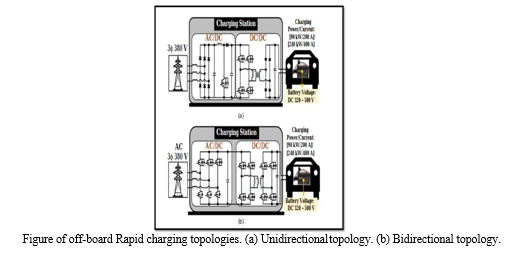
A. Wireless Charging
- Radiative Charging: Radiative Wireless charging gets EM swells, absolutely RF swells or broilers for the force trade through the medium as radiation. The energy traded depends on upon the electric field of the EM surge which is radiative. Due to the well-being issues raised by RF preface these charging generally works in the low-force region.
- Non-Radiative Charging: The square figure of the general non-radiative of a general nonradioactive Wireless charging system is having a transmitter side comprised of
- An AC/DC therapy, which changes over substituting current (AC) to coordinate current (DC).
- A DC/DC converter, which modifies the voltage of a wellspring of DC starting with one position and also onto the next.
- A DC/AC inverter, which changes DC to AC.
The beneficiary side is made out of
- An AC/DC rectifier, which changes over high-frequency AC into DC.
- A DC-to-DC converter, which tunes the voltage of the DC.
- A Mound for charging operations.
The below development is likewise categorized into three types considering the coupling of the circles for the trading of the force. They are inductive coupling, magnetic coupling, and capacitive coupling.
- Capacitive Coupling: In this capacitive coupling, the attainable measure of the coupling capacitance depends on the region involved by the apparatus.
- Inductive Coupling: In this method, the electrical energy is moved between two loops dependent on the magnetic field enlistment. Inductive Power Transfer (IPT) happens when the essential curl is energized by the source which overwhelmingly creates the differing magnetic field over the optional loop of the energy beneficiary which is inside the field, for the most part not exactly the frequency of the field.
- Magnetic Resonance Coupling: In this method the coupling-based fleeting wave coupling which creates and moves the electrical energy between the resounding loops through fluctuating or influencing magnetic fields. As the two full loops are working in the same thunderous recurrence, they are determinedly coupled, high energy moves proficiency with little spillage to non-resounding externalities. Because of the property of reverberation, magnetic reverberation coupling is a good situation of resistance to the region and recognizable pathway trade essential. Magnetically coupled resonators indicated the ability as far as force transmitting for significant distances than the inductive coupling with higher efficiency than that the of RF radiation approach. Besides, the one transmitter resonator can be coupled to various receiver resonators. As such it engages in concurrent charging of different contraptions.
- Acoustic Power Transfer: In this innovation, ultrasonic are sound waves used to transmit the force through the dielectric air media. This innovation is a recently developed one to have a biocompatible Wireless force move procedure in bio-clinical implantation i.e., implantable clinical gadgets. The primary standard included is "Ultrasonic resonance". The inciting of ultrasonic waves is extensively lower than that of electromagnetic waves which are utilized in acceptance coupling or radiative innovation. The ultrasonic Wireless force transmission gadget can be effectively planned and proposed to have a short frequency with decently low activity recurrence. Subsequently utilizing ultrasonic waves, significant distance power transmission is conceivable while the gadget keeps up generally little gadget size contrasted with electromagnetic wave gadgets. The ultrasonic waves are created utilizing the Magneto-strict ion or piezoelectric technique. The ultrasonic waves are utilized not for power movement yet in addition for information transmission.
The force transmission utilizing ultrasonic is as per following:-
- First, electrical energy is used to produce ultrasonic waves from a piezo-electric part or transducer.
- The ultrasonic waves are transmitted through the media. It can have the capacity to travel 10-50m indoors (for implantable gadgets) and 100-200m in the open air.
- The transmitted ultrasonic is gotten by the beneficiary where the piezo part is utilized to change over the ultrasonic waves into electrical energy. The whole system is Piezo-electric impact and transverse Piezo- electric impact.
V. ENEGRY CONVERSION EFFICIENCY
Wired charging is not completely efficient. Every step of the way from the grid to the battery results in energy loss, primarily in the form of heat. Furthermore, irrespective of the brand, a wired EV charger is composed of numerous components, each of which may be more or less efficient than analogous components in another charger. So, the "efficiency" of transferring energy from the grid to the battery spans a wide range; a typical position 2 home charger operates in the 83-94% efficiency grid-to-battery range, depending on which one you buy. Wireless force innovation allows for the elimination of the final string connections required to recharge the smaller electronic devices. This promising innovation has fundamentally advanced over the previous decades, yielding a variety of simple applications. This article provides a global overview of wireless charging advancements. Beginning with the development history, it has also presented the fundamentals, basic rules, and global norms of wireless charging, followed by their charging change proficiency rates. As an asset portion, the consolidation of Wireless accusing the current correspondence system creates new open doors. This Wireless charging has viable applications in various correspondence systems, for example, near-field beam forcing plans, circulated wireless charger organization methodologies, and numerous entrance control for wireless force correspondence, all of which should be investigated.
VI. ADVANTAGES OF DIFFERENT TYPES OF CHARGING
A. Contrasting with the customary charging methods Wired Charging has the accompanying advantages:
The main advantage behind wired charging is that it prioritizes speed for the stoner – wired charging takes lower time to completely charge a phone’s battery than that of a wireless charging pad, and depending on the quality of the string the phone can continue to be used whilst it’s charging!
- Universal comity for aged models, as some phone models might not have wireless charging support.
- It’s always a benefit to take for the trip since lines can always be compacted and put into a small carrying bag wireless charging is more solid and can take up more space.
- Utmost lines can also be used for faster train transfers – should anyone wish to snappily move lines from their phone to their computer, they can connect the two biases through a string.
- Public places also prefer to wire charging too! USB anchorages and entrapments are frequently erected into chairpersons inside cafés, and there are charging stations made available for us to use.
- More efficient. Nearly 100 of the energy that enters the line reaches the battery to be charged. Wireless charging converts electricity into an oscillating magnetic field, and energy is lost. The device to be charged can not capture all the energy in that magnetic field and convert it back into electricity in a wire.
- Easy to know when the device is connected. To connect the device, draw the line. With wireless, the device has to be placed in the correct spot on the charging pad. I have an iPhone charging pad in my room. Until the phone is in the right place, also it won’t charge.
- You can use the device while it’s charging. With a long-enough charge cable, I can talk on my iPhone while it charges, or read it. While Mobile sitting on a wireless charger isn’t very useful. Once I put the wireless charger on my iWatch, I have to remember to put it on my wrist again when it’s charged.
B. Contrasting with the customary charging methods Wireless Charging has the accompanying advantages:
- Firstly, it improves the ease of use as the problem of associating links is ousted
- Secondly, assorted brands and particular models can be charged by a similar charger.
- Thirdly, it upgrades the adaptability, particularly for the gadgets which supplant their batteries or associating strings.
- Fourthly, it creates better sturdiness (i.e., water verification and residue confirmation) for contact-free gadgets.
- Fifthly, Wireless charging can give the requested control by the charging devices on demand form and thusly progressively versatile and viable. By and by, ordinarily Wireless charging acquires higher execution costs stood out from wired charging. Initially, a Wireless charger ought to be presented as a replacement for the customary charging line. Second, a versatile one requires the implantation of a Wireless force receiver.
VII. LATEST INNOVATIONS
After the smartphones revolution across the globe today, fast charging has almost become a typical and necessary configuration. For almost all the smart devices including smart watch, fitness bands, true wireless ear buds, Bluetooth headphones supports fast charging technology where typical devices gives backup up to 10hours in just 10minutes charge. Apple is quite slow in this race as their latest fastest charging technology is only 25W whereas android devices has significantly worked upon this field. 25W charging was available in android 4years back and now it is working on 200W charging which is surprisingly fast and can charge a typical 4000mAh battery within just 10 to 15 minutes whereas if we look just 5 years back it look more than 2 hours to get a phone fully charged. All smartphone oems like Xiaomi, Samsung, Realme, Oneplus are into this race and bringing latest charging trends to end users rapidly. Not only in case of wired charging but high speed 80W wireless charging is also now available to us in various brands. The reverse wireless charging technology is also evolving by a good pace. Reverse wireless chagrining we can use to charge any smart device wirelessly by just putting the other device in its contact. Batteries are now split into 2parts and charged both ways to achieve more fasters speed, this technology is also know as split charging. Along with speed and capacity battery’s health and longevity is also a key factor that is also taken into great consideration for user safety. Manufacturers has to pass various Quality Checking ratings before selling to mass. Various organizations like TUV Rhienland rates the safety in various parameters of the device. It's important to note that fast charging technology is not only a technique but a “system engineering”. this suggests that it requires the combination of different aspects to form a system. we've the fast charging devices, chargers, and charging protocol as individual aspects of fast charging technology. With the progress of the fast charging development, it appears that there’ll be a bottleneck moving forward
VIII. AIR CHARGING
Air Charging is the most recent and latest trend in charging universe introduced by smartphone vendor in Jan, 2021. It is a futuristic technology where the smart devices can be charged any time anywhere through a device emitting air waves containing charging energy. It can charge multiple devices simultaneously while we are gaming, walking or doing anything without need of any contact and charges even anything is in between. In this technique the smart devices are fitted with miniature sized beacon receiving antenna arrays. Here from the transmitter millimeter waves are released and they are received by the device and the signal is converted into energy by a rectifier circuit. It is still in initial stage and can charge up to 5W speed only with in the radius of few meters preferably inside a room. Soon it will be commercially rolled out and maybe it will be installed in various parts of our city so that we need not carry any charger and our devices will get charged on the way anywhere, anytime. More R&D works are carried out on this technology now to make it more feasible to use.
IX. ACKNOWLEDGMENT
We, Joydeep Chandra, Neha Sharma, Vikram Kumar Jha would like to convey our heartfelt gratitude to Mr. Nikhil Aggarwal for his tremendous direction and assistance in the completion of this research paper. I would also like to thank Apex Institute of Technology, Chandigarh University, for providing me with this wonderful opportunity to work on this research paper with the topic, “Charging and its evolution”.
Conclusion
Charging force innovation offers the chance of evacuating the final string associations required to recharge the reduced electronic gadgets. This promising innovation has fundamentally advanced during the previous decades and built up various easy-to-understand applications. In this article, a worldview overview of charging advances has been introduced. Starting from the advancement history, it has additionally presented the basics, fundamental rules, and global norms of charging followed by their charging change proficiency rates. The consolidation of Wireless accusing of the current correspondence system makes new open doors just as asset portion. charging has viable applications in different correspondence systems like near-field beam forcing plans, circulated charger organization methodologies, and numerous entrance control for charging force correspondence which ought to be also inspected.
References
[1] https://witricity.com/newsroom/blogs/what-is-efficiency-how-do-you- measure-it-and-why-should-you-care/ [2] https://blog.ravpower.com/2017/09/wireless-charging-technology- history-future/ [3] https://www.researchgate.net/publication/346306257_Review_on_Bat tery_Technology_and_its_Challenges [4] https://batteryuniversity.com/article/bu-101-when-was-the-battery- invented [5] https://www.google.com/search?q=how+to+charge+the+device+in+a ncient+times&rlz=1C1GCEA_enIN986IN986&oq=how+to+charge+t he+device+in+anc&aqs=chrome.1.69i57j33i160l4j33i22i29i30l5.995 5j0j7&sourceid=chrome&ie=UTF-8 [6] https://www.cellularsales.com/blog/wireless-charging-vs-wired-what- are-the- benefits/#:~:text=wired%20charging%20speed%20is%20one,the%20 same%20amount%20of%20time. [7] https://www.researchgate.net/publication/348831507_A_Comprehens ive_State-of-the- Art_Review_of_WiredWireless_Charging_Technologies_for_Battery _Electric_Vehicles_ClassificationCommon_TopologiesFuture_Resear ch_Issues [8] https://www.google.com/search?q=first+battery+picture&rlz= 1C1GCEA_enIN986IN986&oq=first+battery+pic&aqs=chro me.1.69i57j33i160l2.14854j0j7&sourceid=chrome&ie=UTF- 8#imgrc=zc607vEy6txjzM [9] https://www.google.com/url?sa=i&url=https%3A%2F%2Fsty lesatlife.com%2Farticles%2Fdifferent-types-of-phone- chargers%2F&psig=AOvVaw23OnI0d4UL9bZR6wCIOJHb &ust=1666203154099000&source=images&cd=vfe&ved=0C A0QjRxqFwoTCND-zMuw6voCFQAAAAAdAAAAABAx [10] https://www.gsmarena.com/xiaomi_introduces_mi_air_charge_wirele ss_charging_from_across_the_room-news-47461.php [11] https://www.gizchina.com/2021/07/27/top-5-trends-in-the- smartphone-fast-charging-industry/
Copyright
Copyright © 2023 Joydeep Chandra, Vikram Kumar Jha, Neha Sharma. This is an open access article distributed under the Creative Commons Attribution License, which permits unrestricted use, distribution, and reproduction in any medium, provided the original work is properly cited.

Download Paper
Paper Id : IJRASET50417
Publish Date : 2023-04-14
ISSN : 2321-9653
Publisher Name : IJRASET
DOI Link : Click Here
 Submit Paper Online
Submit Paper Online

